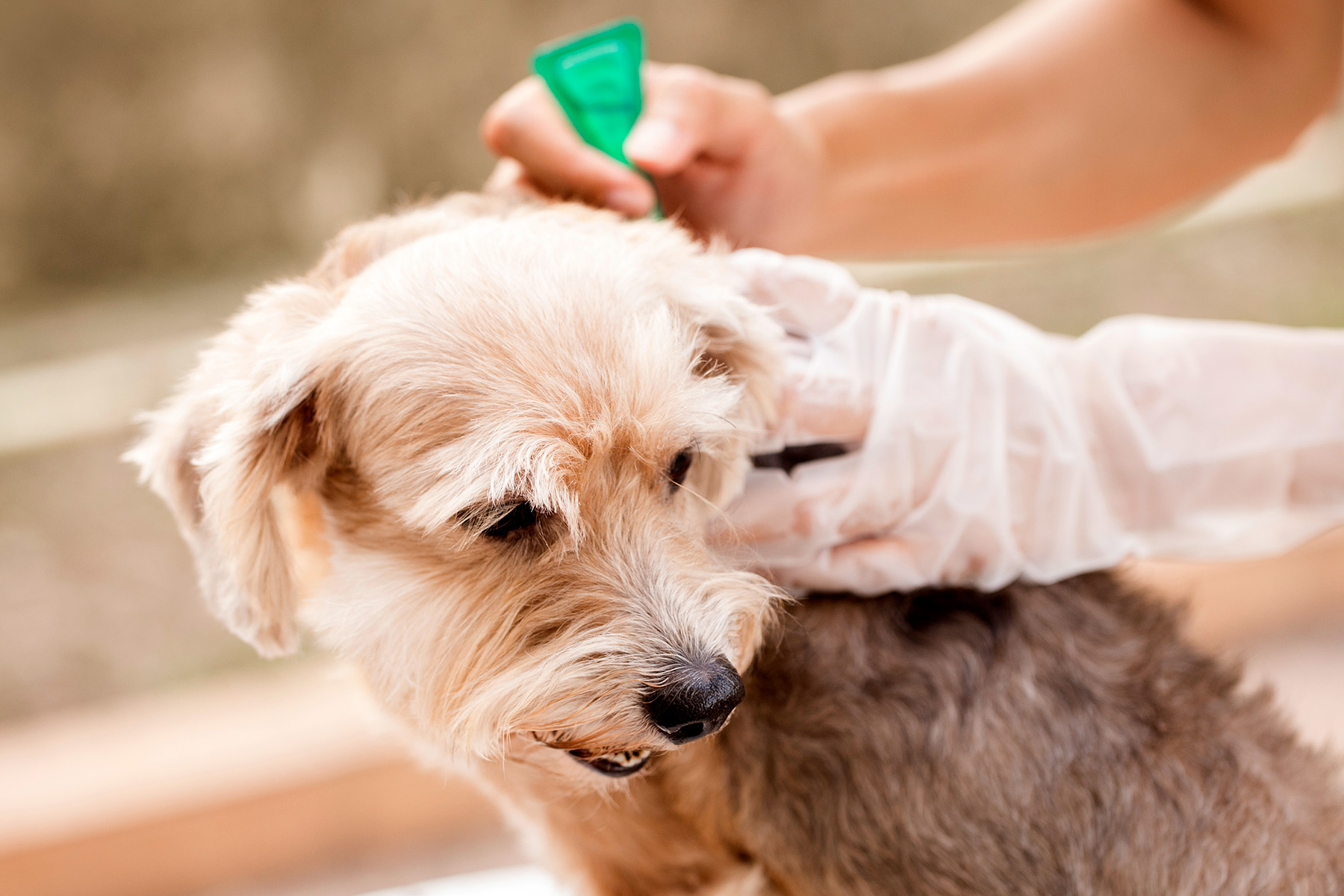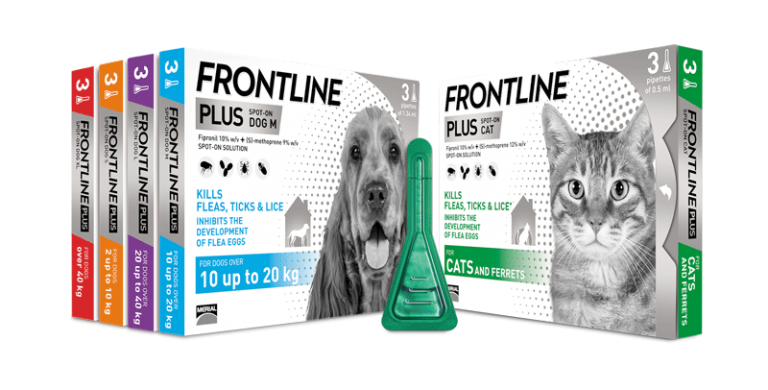Getting a flea infestation clear for your Pet can be challenging. It may take as long as a quarter of a year of determining the treatment of pets and the home before you have indeed picked up the high ground.
But before you chose to pick any treatment, you must understand the reason behind the flea infestation.
Insects May Turn Out to be Increasingly Dynamic Before They Die-
The fixing in FRONTLINE Spot on and FRONTLINE Plus that kills fleas make them hyperactive before they die. So, you may see fleas rise to the top of your Pet’s body, and your Pet may feel more bothersome than expected until those insects are killed.
Insect pesticides do not kill fleas in a flash – the flea needs to meet the fixing, retain it, and afterward begin to feel the impacts. It’s similar to you contracting a virus. Some time will slip by between you having contact with the disease and eventually getting sick. Even though it might happen much snappier, it can take as long as 24 hours for Frontline plus to work.
Fleas are Brought Out in your Home and Hopping Onto your Pet

There are typically a lot increasingly juvenile flea life stages (eggs, hatchlings, and pupae) in your home than grown-up insects on your Pet. Flea eggs can be continually brought forth out when the temperature and dampness are correct, and new adult fleas are steadily rising out of casings (pupae). These new insects possibly bring forth out when a host your Pet is close by, as they must have a blood feast to endure and rise.
Your Pet has Gotten a ‘hitch-hiker’ Flea
Indeed, even once you are trying to kill any fleas in your home, it is feasible for your Pet to get fleas outside, for instance, in your nursery or during strolls. Insect eggs and pupae can likewise be brought into the home on shoes or apparel.
It is highly predictable that you might have used FRONTLINE Plus for this purpose by now. But you might be wondering why the fleas have not gone yet. How much time does it take for Frontline Plus to work?
Here are the reasons that fleas have saved the spot on your Pet.
No products found.
Dismissing Flea Hotspots-
Most homes have ‘hotspots’ where insect eggs and defecation gather. You can discover these territories where your Pet rests during the day or beds down for the evening. Since the flea hatchlings that incubate from these eggs don’t travel exceptionally far, focusing on these zones is your primary protection against insects. If conceivable, watch your Pet for the day and see where it spends most of its time. Relaxing, prepping, snoozing, and merely lying around may not look like a lot.
Yet, these calm spans allow insect eggs to tumble to the ground and start the cycle once more. Concentrate your medicines on these places, and if electrical outlets are found close by, have a go at connecting electric insect traps to decrease the populace.
If the trap is not getting insects inside 48 hours, move to an alternate area close to another hotspot. Remember to clean your vehicle if your Pet often goes with you. Vehicle seats, covers, cases, and transporters offer another perfect spot for usual hotspots to create.
Not Treating the Environment
The perfect flea condition is between 70-85°F, with a humidity of 70%. If you can, keep your home beneath 70°F, and utilize a dehumidifier or forced air system, you have trouble with mugginess.
A pet’s textured body gives the sodden, warm home that fleas need, mainly if your Pet goes outside a great deal and gets wet from the outside. Clean your pets when they come inside and see if they are carrying any fleas and dirt.
Not Treating Often Enough
Insects experience an actual existence pattern of egg, hatchlings, pupae, and grown-up. Most insect medicines kill grown-up fleas, yet fleas can keep on developing for a considerable length of time after you think an infestation has finished.
At the point when a recently risen female insect finds a host, she can lay eggs inside one day. Conventional treatment is the way to keeping fleas under control, yet washing your Pet never really forestall fleas.
While numerous grown-ups will wash away, the eggs will remain. When you wrap up the cleanser, more insects will hop directly back on. Regardless of whether you are utilizing a special flea treatment or not, a customary routine is essential to kill fleas.
Just Treating the Fleas, You See
Grown-up insects make up about 5% of an infestation, and these are commonly the ones you see on your Pet. The rest you can’t see the eggs, hatchlings, and pupae. Eggs come out in 21 days, and the hatchlings sink into textures like furnishings and floor covering. Here they will devour dead skin cells and hair. Since 95% of the insect’s life is spent outside the grown-up stage, flea infestations can set aside an extended effort to destroy.
To treat the insects, you can’t wash your entire bed, covers, and pads in boiling water: steam clean different stringy materials, especially those in the living and rooms. Use food-grade diatomaceous earth around problem areas, including around pet sheet material and resting territories. You can treat the two rugs and wood floors, applying in lines around territories most frequented.
Utilizing the Wrong Treatments
Numerous flea medicines are poisonous to youngsters and pets, significantly the drops that are applied to the traps, including powders, collars, and showers. These are pesticides and ought not to be utilized without a good idea.
There are currently types of flea treatments that are far less dangerous, albeit marginally less successful than straight-up pesticides. One of the most famous is called Comfortis, which keeps going a month for every portion and is recommended by your veterinarian. The critical fixing is Spinosad, which is a natural substance that is produced using a dirt bacterium that has been tried intensely by the EPA for wellbeing impacts.
Try not to purchase flea pesticides from the pet store until you have talked with your veterinarian to examine the correct treatment for your Pet. Normal showers, and electric insect traps can give you much more assurance. There are additionally refillable cushions for insect traps to keep them working their best.
Re-infestation from Outdoors
Wind stream and daylight kill flea hatchlings, so the more splendid and airier your yard, the more uncertain your Pet will bring a flea inside. Keep your yard spotless and liberated from the garbage. That implies cutting your garden routinely and cutting bushes with the goal that fleas have fewer hidden spots to live.
Keeping your yard clean additionally stops wild creatures from flourishing there, carrying their insects with them. Raccoons and homeless felines are the most well-known trespassers. Exploration likewise recommends that insect-eating nematodes are very compelling at killing flea hatchlings outside.
If you speculate your Pet’s fleas are originating from your yard, buy nematodes from your nearby nursery community and apply to obscure, soggy zones where insects flourish utilizing a grass sprayer.
Invasion from Other Pets
If you have more than one pet at your home, treat everyone as an expected host for your flea issue, regardless of whether just one is scratching. Brushing, appropriate prepping, and family unit tidiness goes far, yet getting extreme with vacuuming, flea traps, and diatomaceous earth is progressively viable.
Treat every one of your pets’ beds and resting/dozing zones. You can even rub earth into your Pet, but since it is a slight residue, be mindful so as not to make lung issues for anyone who may experience the ill effects of asthma or other breathing challenges. Furthermore, abstain from applying almost a house fan or in breezy situations.
Not Treating Year Round
It is entirely false that your Pet cannot get infected by fleas in the winter. Fleas can live outside in the temperatures that are as low as 33°F for five days, and flourish in creep spaces and yards. The pupae can lie torpid for longer than a year until they end up in the correct temperature.
You can face the challenge of disregarding insects for a couple of months, yet risks are that one flea will increase when it hitches a ride into your home. Keep up your flea medicines during a chilly climate for whatever length of time that fundamental.
Disregarding Carpets
As referenced before, rugs are a significant shelter for insect eggs and hatchlings. They ought to be vacuumed habitually, and, if conceivable, steam cleaned to execute eggs. Make sure to expel vacuum sacks from your machine after cleaning and spot outside the house to forestall re-pervasions.
A vacuum with a True HEPA channel will have the option to diminish the populace significantly adequately. You can likewise treat your rug utilizing food-grade diatomaceous earth. Sprinkle over zones used habitually by your Pet, including those under pet sheet material.
Hold up a few days, and afterward, vacuum up. You can likewise spread diatomaceous earth in lines along with dividers and fissure close to covered zones.
Utilizing Flea Treatments Improperly
This is an easy decision and a typical subject in these techniques. However, doing just a large portion of the activity or an inappropriate thing is more awful than not doing it by any stretch of the imagination since insects promptly adjust to their condition.
Medicines utilized inappropriately permit fleas the opportunity to get insusceptible to controls with each new age. This can prompt interminably bigger flare-ups as insects proceed to increase and become progressively safe. Try not to put your Pet in danger by neglecting to adhere to guidelines.
Staying Flea-Free
Insects are awkward, and it merits paying attention to them. Not exclusively would they be able to nibble and cause diseases, they can move tapeworms to your pets. Their capacity to hop multiple times their length, drink numerous times their body weight, and go for 100 days between dinners makes them hard to battle.
Yet, by being proactive, you can forestall infestations. A comprehensive arrangement that incorporates neatness, prepping, regular medicines, and a top-notch diet can guarantee that your Pet remains cheerful and insect free.
This article was curated through HomeSenator’ Contributor Program. If you would like to home decor guest post, send us your submission today!

